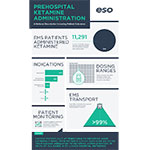ESO Publishes Peer-Reviewed Paper On Prehospital Ketamine Use At A National Level

Largest study of its kind, research based on more than 11,000 EMS patients receiving ketamine
AUSTIN, Texas–(BUSINESS WIRE)–ESO, the leading data and software company serving emergency medical services (EMS), fire departments, hospitals, and state EMS/Trauma offices, today announced findings from a peer-reviewed research study focused on prehospital ketamine use. The study uses data from the ESO Data Collaborative, one of the largest prehospital research databases in the country. The findings are based on more than 11,000 patients receiving ketamine by EMS from January 1, 2019 to December 31, 2019.
“The ketamine conversation has reached a national, mainstream audience,” said Dr. Brent Myers, Chief Medical Officer for ESO. “We felt it imperative to look at the full range of ketamine use and impact through an objective, data-driven lens to understand the effect of the medication on patients in both the prehospital setting and, to the extent we have data, through hospital outcome.”
Key Findings Include:
- EMS Ketamine Administrations: Based on data from the ESO Data Collaborative, EMS administered ketamine to 11,291 patients from January 1, 2019-December 31, 2019. Ketamine was given for a variety of indications, including, but not limited to, pain management, sedation, airway procedures, and seizure treatment.
- EMS Transport: More than 99 percent of patients receiving ketamine were transported by EMS to a hospital facility.
- Hospital Outcomes: Patients who received ketamine often had concomitant serious medical conditions or injuries and about half were admitted to the hospital.
- Ketamine and Mortality: Nearly 95 percent of patients with an emergency department disposition left the hospital alive. Of those who died in the hospital, ketamine could not be excluded as a contributing factor in 0.3 percent of cases – or 6 out of 1,878 cases.
“ESO has brought forth a large and robust data set that provides clarity on the safety of ketamine used in the field for behavioral emergencies when administered by providers overseen by EMS physicians,” said Dr. Michael Levy, President of NAEMSP. “NAEMSP, the largest organization representing EMS physicians and other professional EMS providers, thanks ESO for providing these data to help support our best practice model of EMS.”
“Our key mission is to help improve the health and safety of our communities through the power of data,” added Dr. Myers. “We hope the data from this research help contribute to a meaningful and rational conversation about the use of ketamine by EMS providers across the country as we explore and examine tools to help first responders keep patients and themselves safe.”
Visit Annals of Emergency Medicine to view the peer-reviewed research in its entirety.
About the Ketamine Research
The data are based on 11,291 patient records from the ESO Data Collaborative from January 1, 2019-December 31, 2019 with documented ketamine administration.
About ESO
ESO (ESO Solutions, Inc.) is dedicated to improving community health and safety through the power of data. Since its founding in 2004, the company continues to pioneer innovative, user-friendly software to meet the changing needs of today’s EMS agencies, fire departments, hospitals and state EMS offices. ESO currently serves thousands of customers throughout North America with a broad software portfolio, including the industry-leading ESO Electronic Health Record (EHR), the next generation ePCR; ESO Health Data Exchange (HDE), the first-of-its-kind healthcare interoperability platform; ESO Fire RMS, the gold standard for fire Record Management Systems; trauma, burn and stroke registry software; and ESO State Repository. ESO is headquartered in Austin, Texas. For more information, visit www.eso.com.
Contacts
Andy Prince
[email protected]
(512)-289-4728





